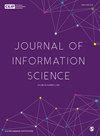利用深层语义进行一步式多视图聚类
IF 1.7
4区 管理学
Q3 COMPUTER SCIENCE, INFORMATION SYSTEMS
引用次数: 0
摘要
与传统的信号视图聚类相比,多视图聚类(MVC)因多视图信息的互补性而有望提高性能。然而,现有的多视图聚类方法是通过信号层映射来利用聚类结构,因此无法利用复杂和交错多视图数据中的深层语义信息。此外,现有方法通常将多视图融合和聚类分开进行,导致性能不尽如人意。针对上述问题,本文提出了通过深层语义挖掘(DLSE)的一步式 MVC 方法,利用深层语义信息,一步式学习指标矩阵。具体来说,我们设计了一种新颖的深层矩阵因式分解(DMF)范式,通过分层方案来利用层次语义,从而迫使来自同一聚类的样本在低维空间中逐层靠近。此外,为了使学习到的表示保留数据的局部几何结构,DLSE 引入了局部保留正则化来引导 DMF。同时,通过光谱旋转融合,可以直接获得聚类指标。大量实验证明,DLSE 与一些最先进的方法相比更具优势。本文章由计算机程序翻译,如有差异,请以英文原文为准。
One-step multi-view clustering via deep-level semantics exploiting
Multi-view clustering (MVC) has gained promising performance improvement compared with traditional signal-view clustering due to the complementary information of multiple views. However, existing MVC methods exploit clustering structure by utilising signal-layer mapping, such that they cannot exploit the underlying deep-level semantic information in complex and interleaved multi-view data. Moreover, existing methods usually conduct multi-view fusion and clustering separately, which results in unpromising performance. To address the above problems, one-step MVC via deep-level semantics exploiting (DLSE) is proposed to exploit deep-level semantic information and learn the indicator matrix using a one-step manner. To be specific, a novel deep matrix factorisation (DMF) paradigm is designed to exploit the hierarchical semantics via a layer-wise scheme, so that samples from the same clusters are forced to be closer in the low-dimensional space layer by layer. Furthermore, to make the learned representation preserve the local geometric structure of data, DLSE introduces a local preservation regularisation to guide DMF. Meanwhile, by employing spectral rotating fusion, the cluster indicator can be obtained directly. Extensive experiments demonstrate the superiority of DLSE in contrast with some state-of-the-art methods.
求助全文
通过发布文献求助,成功后即可免费获取论文全文。
去求助
来源期刊

Journal of Information Science
工程技术-计算机:信息系统
CiteScore
6.80
自引率
8.30%
发文量
121
审稿时长
4 months
期刊介绍:
The Journal of Information Science is a peer-reviewed international journal of high repute covering topics of interest to all those researching and working in the sciences of information and knowledge management. The Editors welcome material on any aspect of information science theory, policy, application or practice that will advance thinking in the field.
 求助内容:
求助内容: 应助结果提醒方式:
应助结果提醒方式:


